Modules
In-depth information on select components.
Veins provides a comprehensive suite of IVC-specific models that can serve as a modular framework for simulating applications. Each model is contained in one or more of what OMNeT++ terms a module, which can be instantiated in a running simulation to provide required functionality.
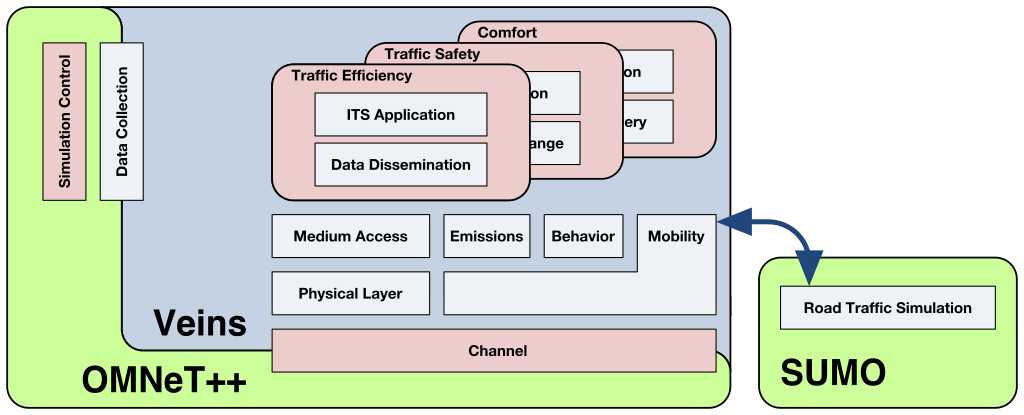
Modular structure of Veins.
How to use each module is documented in the module itself in the form of doxygen comments.
This can be transformed into API documentation by clicking Project > Generate NED Documentation... in the IDE, or from the command line, by running make doxy.
To start reading the module documenation, open doc/index.html in your browser.
This gives you the most up-to-date form of documentation specific to your version of Veins.
This page gives a brief overview of some modules that are either central to the functionality of Veins, not yet contained in the standard distribution, or that require more extensive documentation, in particular pictures or videos.
MiXiM
For accurate modeling of physical layer effects, especially for modelling and working with the distribution of transmit power over time and space, Veins relies on functionality provided by MiXiM, which has been integrated into Veins.
This model is included since Veins 2.0.
TraCI
Veins instantiates one network node per vehicle driving in SUMO.
This task is handled by the TraCIScenarioManagerLaunchd module: it connects to a TraCI server (SUMO or veins_launchd) and subscribes to events like vehicle creation and movement.
For each vehicle created in SUMO, it instantiates one OMNeT++ Compound Module in the OMNeT++ simulation.
This module is assumed to contain a mobility submodule of type TraCIMobility.
At regular intervals it will use this module to advance the simulation in SUMO and update the node's mobility information (such as position, speed, and direction) based on the behavior of the vehicle.
For quick tests, the TraCIMobility module also includes functionality to stop a vehicle at a predefined point in time (configured via its accidentStart, and accidentDuration parameters).
Full API documentation of these modules is available as documented above.
The most interesting parameters of TraCIScenarioManagerLaunchd are:
- updateInterval
- the time interval between updates of the SUMO simulation
- moduleType
- which OMNeT++ module to instantiate for each driving vehicle
- port
- on which TCP port to connect to veins_launchd
- seed
- which random number seed to configure SUMO for
- roiRects
- for only simulating vehicles currently driving within a ROI, that is, a Region of Interest
Application modules can use the TraCICommandInterface class and related classes, conveniently accessible from TraCIMobility, to interact with the running simulation.
The following example shows how to make a vehicle aware of slow traffic on a road called Second Street, potentially causing it to change its route to avoid this road.
mobility = TraCIMobilityAccess().get(getParentModule());
traci = mobility->getCommandInterface();
traciVehicle = mobility->getVehicleCommandInterface();
traciVehicle->changeRoute("Second Street", 3600);
Some of the other vehicle related commands are setSpeed or setParking.
Similar methods are available for the whole simulation (e.g., addVehicle, addPolygon), roads (getMeanSpeed), individual lanes (getShape), traffic lights (setProgram), polygons (setShape), points of interest, junctions, routes, vehicle types, or the graphical user interface.
How to use these modules is demonstrated in the source code of the Veins tutorial example.
Again, a list of all 80+ available methods can be found in TraCICommandInterface.h or the autogenerated module documentation.
This model is included since Veins 0.0.
Physical Layer
Veins includes an optimized physical layer implementation that can perform short-circuit evaluation of loss models for tasks like determining if receive power is above a certain threshold, thus speeding up simulations by up to an order of magnitude.
Please refer to our publication for a detailed description of the model itself, including a thorough description and an evaluation.
-
F. Bronner and C. Sommer, "Efficient Multi-Channel Simulation of Wireless Communications," Proceedings of 2018 IEEE Vehicular Networking Conference (VNC), December 2018, pp. 1-8. [DOI]
How to use this module is demonstrated in the source code of the Veins tutorial example.
This model is included since Veins 5.0.
IEEE 802.11p and IEEE 1609.4 DSRC/WAVE
Veins includes a model of 802.11 that is tailored to use in vehicular networks, particularly IEEE 802.11p. This includes QoS channel access conforming to EDCA (that is, 4 queues with different access categories) and accurately captures frame timing, modulation and coding, and channel models.

Veins also includes higher layer models of the DSRC/WAVE stack for channel hopping according to the standard (i.e., switching between CCH and SCH, that is, control channel and service channel), if this is desired. It further includes Wave Short Message (WSM) handling, and periodic beaconing, e.g., for sending WAVE service announcements, BSMs, or CAMs.

Please refer to our publications for a detailed description of the model itself, including a thorough description and an evaluation.
-
 David Eckhoff, Christoph Sommer and Falko Dressler, "On the Necessity of Accurate IEEE 802.11p Models for IVC Protocol Simulation," Proceedings of 75th IEEE Vehicular Technology Conference (VTC 2012-Spring), Yokohama, Japan, May 2012, pp. 1-5.
[DOI]
David Eckhoff, Christoph Sommer and Falko Dressler, "On the Necessity of Accurate IEEE 802.11p Models for IVC Protocol Simulation," Proceedings of 75th IEEE Vehicular Technology Conference (VTC 2012-Spring), Yokohama, Japan, May 2012, pp. 1-5.
[DOI]
-
 David Eckhoff and Christoph Sommer, "A Multi-Channel IEEE 1609.4 and 802.11p EDCA Model for the Veins Framework," Proceedings of 5th ACM/ICST International Conference on Simulation Tools and Techniques for Communications, Networks and Systems (SIMUTools 2012), 5th ACM/ICST International Workshop on OMNeT++ (OMNeT++ 2012), Poster Session, Desenzano del Garda, Italy, March 2012.
David Eckhoff and Christoph Sommer, "A Multi-Channel IEEE 1609.4 and 802.11p EDCA Model for the Veins Framework," Proceedings of 5th ACM/ICST International Conference on Simulation Tools and Techniques for Communications, Networks and Systems (SIMUTools 2012), 5th ACM/ICST International Workshop on OMNeT++ (OMNeT++ 2012), Poster Session, Desenzano del Garda, Italy, March 2012.
How to use these modules is demonstrated in the source code of the Veins tutorial example.
This model is included since Veins 2.0.
ARIB STD-T109
A simulation model of the Japanese ARIB T109 standard for ITS in the 700 MHz band has recently been completed. It models both physical layer characteristics and medium access characteristics of the standard's unique combination of TDMA and CSMA/CA.

The MAC layer consists of two different implementations distinguishing between RSUs (base stations) and vehicles (mobile stations). Both share a common abstract base class which contains functionality utilized in both implementations. The MAC layer combines the CSMA/CA functionalitiy from IEEE 802.11p MAC and the IVC-RVC layer from ARIB T109 which utilizes the TDMA scheme.
The model is available on a separate branch of Veins (see the link below), which is only compatible with OMNeT++ 5.
An example simulation is included as a separate ini file and can be executed, e.g., by running ./run -u Tkenv -f arib.ini in examples/veins.
Please refer to our publication for a detailed description of the model itself, including a thorough description and an evaluation.
-
 Julian Heinovski, Florian Klingler, Falko Dressler and Christoph Sommer, "A Simulative Analysis of the Performance of IEEE 802.11p and ARIB STD-T109," Computer Communications, vol. 122, pp. 84-92, June 2018.
[DOI]
Julian Heinovski, Florian Klingler, Falko Dressler and Christoph Sommer, "A Simulative Analysis of the Performance of IEEE 802.11p and ARIB STD-T109," Computer Communications, vol. 122, pp. 84-92, June 2018.
[DOI]
Two-Ray Interference Model
Path loss models are central to accurately modeling information propagation in a vehicular network. An often made, but wrong, assumption is that all signals propagate in close to free space conditions. In fact, particularly on linear unobstructed stretches of roads, any transmission experiences (depending on the distance) either constructive or destructive interference with its own ground reflection. Yet, the often-cited simplified Two-Ray ground model only captures the fact that (for the physics of vehicular networks), path loss increases for distances over approximately 900 meters. Veins therefore includes a Two-Ray Interference model which actually manages to capture ground reflection effects, as illustrated below.
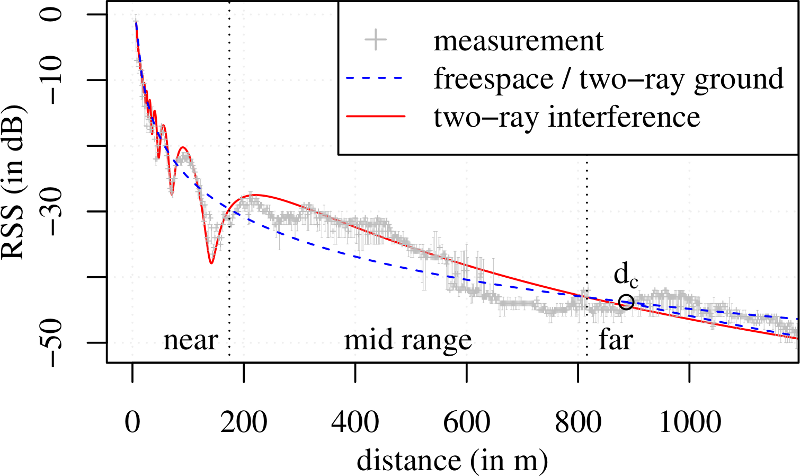
This leads to quite different areas of good signal reception (left: two ray ground, right: two ray interference), as illustrated below in a top-down view.
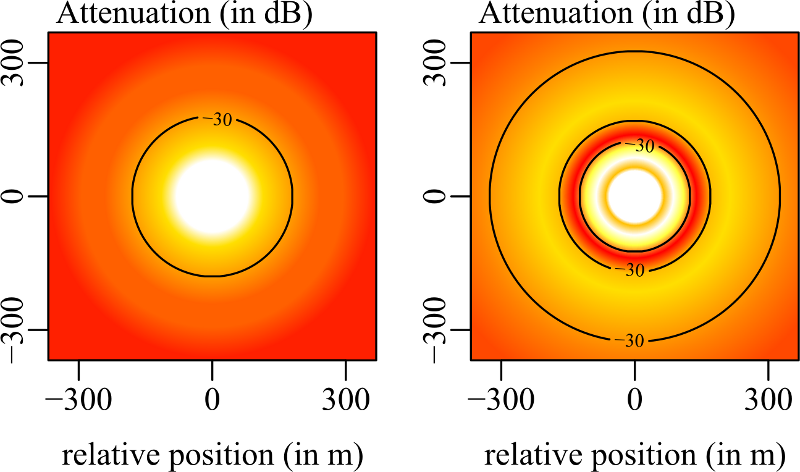
Please refer to our publications for a detailed description of the model itself, including a thorough description and an evaluation.
-
 Christoph Sommer, Stefan Joerer and Falko Dressler, "On the Applicability of Two-Ray Path Loss Models for Vehicular Network Simulation," Proceedings of 4th IEEE Vehicular Networking Conference (VNC 2012), Seoul, South Korea, November 2012, pp. 64-69.
[DOI]
Christoph Sommer, Stefan Joerer and Falko Dressler, "On the Applicability of Two-Ray Path Loss Models for Vehicular Network Simulation," Proceedings of 4th IEEE Vehicular Networking Conference (VNC 2012), Seoul, South Korea, November 2012, pp. 64-69.
[DOI]
-
 Christoph Sommer and Falko Dressler, "Using the Right Two-Ray Model? A Measurement Based Evaluation of PHY Models in VANETs," Proceedings of 17th ACM International Conference on Mobile Computing and Networking (MobiCom 2011), Poster Session, Las Vegas, NV, September 2011.
Christoph Sommer and Falko Dressler, "Using the Right Two-Ray Model? A Measurement Based Evaluation of PHY Models in VANETs," Proceedings of 17th ACM International Conference on Mobile Computing and Networking (MobiCom 2011), Poster Session, Las Vegas, NV, September 2011.
The model can be activated by including an appropriate AnalogueModel statement in config.xml, e.g., as follows.
<AnalogueModel type="TwoRayInterferenceModel">
<parameter name="DielectricConstant" type="double" value="1.02"/>
</AnalogueModel>
This model is included since Veins 2.0.
Obstacle Shadowing
Radio transmissions are heavily impacted by signal shadowing effects. Accurately capturing this is particularly important in vehicular networks operating in suburban and urban environments, where buildings block radio propagation. Veins includes a simple obstacle shadowing model that has been calibrated and validated against real world measurements, as illustrated below.

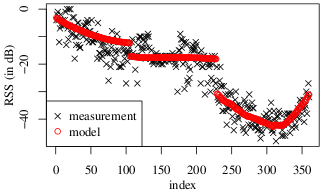
This model will accurately capture the effect that large buildings will block transmissions and weak transmissions are blocked by as little as a small wall, while strong transmissions are only slightly hindered by the presence of buildings in the line of sight, as illustrated in the sample screencast below.
Please refer to our publications for a detailed description of the model itself, including a thorough description and an evaluation.
-
 Christoph Sommer, David Eckhoff, Reinhard German and Falko Dressler, "A Computationally Inexpensive Empirical Model of IEEE 802.11p Radio Shadowing in Urban Environments," Proceedings of 8th IEEE/IFIP Conference on Wireless on Demand Network Systems and Services (WONS 2011), Bardonecchia, Italy, January 2011, pp. 84-90.
[DOI]
Christoph Sommer, David Eckhoff, Reinhard German and Falko Dressler, "A Computationally Inexpensive Empirical Model of IEEE 802.11p Radio Shadowing in Urban Environments," Proceedings of 8th IEEE/IFIP Conference on Wireless on Demand Network Systems and Services (WONS 2011), Bardonecchia, Italy, January 2011, pp. 84-90.
[DOI]
-
 Christoph Sommer, David Eckhoff and Falko Dressler, "IVC in Cities: Signal Attenuation by Buildings and How Parked Cars Can Improve the Situation," IEEE Transactions on Mobile Computing (TMC), vol. 13 (8), pp. 1733-1745, August 2014.
[DOI]
Christoph Sommer, David Eckhoff and Falko Dressler, "IVC in Cities: Signal Attenuation by Buildings and How Parked Cars Can Improve the Situation," IEEE Transactions on Mobile Computing (TMC), vol. 13 (8), pp. 1733-1745, August 2014.
[DOI]
The model can be activated by adding an ObstacleControl module to the simulation and including an appropriate SimpleObstacleShadowing statement in config.xml, e.g., as follows.
Aside from the ObstacleControl module offering the possibility to manually add obstacles to the simulation, the TraCIScenarioManagerLaunchd will automatically detect the presence of an ObstacleControl module and automatically instantiate one obstacle per polygon of type building in SUMO.
<AnalogueModel type="SimpleObstacleShadowing">
<parameter name="carrierFrequency" type="double" value="5.890e+9"/>
</AnalogueModel>
How to use these modules is demonstrated in the source code of the Veins tutorial example.
This model is included since Veins 1.99.2.
Vehicle Obstacle Shadowing
A simulation model of radio shadowing effects caused by other vehicles has recently been completed.
Please refer to our publication for a detailed description of the model itself, including a thorough description and an evaluation.
-
 Christoph Sommer, Stefan Joerer, Michele Segata, Ozan K. Tonguz, Renato Lo Cigno and Falko Dressler, "How Shadowing Hurts Vehicular Communications and How Dynamic Beaconing Can Help," IEEE Transactions on Mobile Computing (TMC), vol. 14 (7), pp. 1411-1421, July 2015.
[DOI]
Christoph Sommer, Stefan Joerer, Michele Segata, Ozan K. Tonguz, Renato Lo Cigno and Falko Dressler, "How Shadowing Hurts Vehicular Communications and How Dynamic Beaconing Can Help," IEEE Transactions on Mobile Computing (TMC), vol. 14 (7), pp. 1411-1421, July 2015.
[DOI]
The model is included since Veins 5.0.
Antenna Patterns
A simulation model that captures angle-dependent gains of antennas has recently been completed.
It includes parameters for different types of real-world antenna patterns, depending on antenna type, mounting point, and roof topology.
An antenna pattern can be configured by setting a physical layer's antenna parameter to an XML statement configuring the type of antenna, along with type-dependent parameters.
If no antenna pattern is specified, the physical layer defaults to 0 dBi gain isotropic.
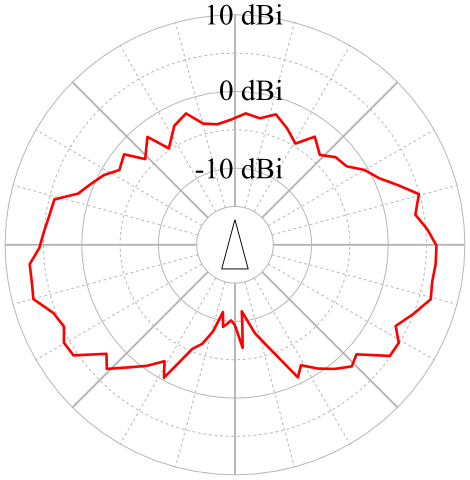
At the moment, only one antenna pattern type, SampledAntenna1D, is implemented.
It defines an antenna pattern using a single parameter, samples, which stores a series of gain samples, taken at equidistant intervals from 0 degress, going clockwise.
This antenna also takes optional random-offsets and random-rotation parameters to add a random gain offset (in dBi), as well as a random rotation offset (in degrees) to each antenna.
The following is an example XML statement configuring such an antenna using very coarse (four) gain samples (+2.0 dBi to the front of the car, +1.1 dBi to the right of the car, -4.0 dBi to the back of the car, +0.9 dBi to the left of the car). This XML statement also applies a random +/- 1 dBi gain to each antenna, as well rotating the whole antenna pattern by a random +/- 1 degree.
<Antenna type="SampledAntenna1D" id="patch">
<parameter name="samples" type="string" value="2.0 1.1 -4.0 0.9"/>
<parameter name="random-offsets" type="string" value="uniform -1 1"/>
<parameter name="random-rotation" type="string" value="uniform -1 1"/>
</Antenna>
Please refer to our publication for a detailed description of the model itself, including a thorough description and an evaluation.
-
 David Eckhoff, Alexander Brummer and Christoph Sommer, "On the Impact of Antenna Patterns on VANET Simulation," Proceedings of 8th IEEE Vehicular Networking Conference (VNC 2016), Columbus, OH, December 2016, pp. 17-20.
[DOI]
David Eckhoff, Alexander Brummer and Christoph Sommer, "On the Impact of Antenna Patterns on VANET Simulation," Proceedings of 8th IEEE Vehicular Networking Conference (VNC 2016), Columbus, OH, December 2016, pp. 17-20.
[DOI]
The model is included since Veins 4.5.
space_Veins Extension
Space_Veins enables the simulation of LEO satellites in Veins.
It is available as a separate download from the following website.
space_Veins WebsitePlease refer to the following publication for a detailed description of the space_Veins extension.
-
 Mario Franke, Florian Klingler and Christoph Sommer, "Poster: Simulating Hybrid LEO Satellite and V2X Networks," Proceedings of 2021 IEEE Vehicular Networking Conference (VNC), November 2021, pp. 139-140.
[DOI]
Mario Franke, Florian Klingler and Christoph Sommer, "Poster: Simulating Hybrid LEO Satellite and V2X Networks," Proceedings of 2021 IEEE Vehicular Networking Conference (VNC), November 2021, pp. 139-140.
[DOI]
Veins LTE Extension
Veins LTE was an extension which allowed Veins to serve as a unified Open Source framework for the simulation of heterogeneous vehicular networks using, for example, IEEE 802.11p DSRC, Wi-Fi, and LTE.
It is now deprecated in favor of directly integrating SimuLTE (or Simu5G) via Veins_INET.
Scroll to Veins_INETVeins LTE integrated Veins and two additional module libraries:
- Veins continued to provide simulation models of DSRC vehicular networks;
- The INET Framework provided general IP connectivity support and models of links using IEEE 802.11 Wi-Fi;
- SimuLTE provided the means of simulating cellular networks using LTE.
Veins LTE was available as a separate download from the following website.
Old Veins LTE WebsitePlease refer to the following publication for a detailed description of the Veins LTE extension.
-
 Florian Hagenauer, Falko Dressler and Christoph Sommer, "A Simulator for Heterogeneous Vehicular Networks," Proceedings of 6th IEEE Vehicular Networking Conference (VNC 2014), Poster Session, Paderborn, Germany, December 2014, pp. 185-186.
[DOI]
Florian Hagenauer, Falko Dressler and Christoph Sommer, "A Simulator for Heterogeneous Vehicular Networks," Proceedings of 6th IEEE Vehicular Networking Conference (VNC 2014), Poster Session, Paderborn, Germany, December 2014, pp. 185-186.
[DOI]
Veins VLC Extension
Veins VLC enables the simulation of Visible Light Communication (VLC) in Veins. By means of this, realistic simulation of heterogeneous vehicular networks consisting of Vehicular VLC (V-VLC) and IEEE 802.11p DSRC becomes possible.
Veins VLC is available as a separate download from the following website.
Veins VLC WebsitePlease refer to the following publication for a detailed description of the Veins VLC extension.
-
A. Memedi, H. Tsai and F. Dressler, "Impact of Realistic Light Radiation Pattern on Vehicular Visible Light Communication," Proceedings of GLOBECOM 2017 - 2017 IEEE Global Communications Conference, December 2017, pp. 1-6. [DOI]
Plexe: Platooning Extension for Veins
Plexe is an extension of Veins which permits the realistic simulation of platooning (i.e., automated car-following) systems. It features realistic vehicle dynamics and several cruise control models, permitting the analysis of control systems, large-scale and mixed scenario, as well as networking protocols and cooperative maneuvers.
Plexe is available as a separate download from the following website.
Plexe WebsitePlease refer to the following publication for a detailed description of the Plexe extension.
-
 Michele Segata, Stefan Joerer, Bastian Bloessl, Christoph Sommer, Falko Dressler and Renato Lo Cigno, "PLEXE: A Platooning Extension for Veins," Proceedings of 6th IEEE Vehicular Networking Conference (VNC 2014), Paderborn, Germany, December 2014, pp. 53-60.
[DOI]
Michele Segata, Stefan Joerer, Bastian Bloessl, Christoph Sommer, Falko Dressler and Renato Lo Cigno, "PLEXE: A Platooning Extension for Veins," Proceedings of 6th IEEE Vehicular Networking Conference (VNC 2014), Paderborn, Germany, December 2014, pp. 53-60.
[DOI]
Artery: ETSI ITS-G5 protocol simulation in Veins
Artery is an extension of Veins which enables V2X simulations based on ETSI ITS-G5 protocols like GeoNetworking and BTP. Single vehicles can be equipped with multiple ITS-G5 services through Artery's middleware, which also provides common Facilities for these services.
The closely related ArteryLTE is an extension of Veins LTE (see above) that also includes backend functionality.
Artery and ArteryLTE are available as separate downloads from the following website.
Artery Website ArteryLTE Website
Please refer to the following publication for a detailed description of the Artery extension.
-
 Raphael Riebl, Hendrik-Jörn Günther, C. Facchi and L. Wolf, "Artery - Extending Veins for VANET Applications," Proceedings of 4th International Conference on Models and Technologies for Intelligent Transportation Systems (MT-ITS 2015), Budapest, Hungary, June 2015.
[DOI]
Raphael Riebl, Hendrik-Jörn Günther, C. Facchi and L. Wolf, "Artery - Extending Veins for VANET Applications," Proceedings of 4th International Conference on Models and Technologies for Intelligent Transportation Systems (MT-ITS 2015), Budapest, Hungary, June 2015.
[DOI]
PREXT: Privacy extension for Veins
PREXT is a unified and extensible framework that simulate pseudonym change schemes (i.e., privacy schemes) in VANET. It supports seven privacy schemes of different approaches including silent period, context-based and mix-zone and can be easily extended to include more schemes. It includes adversary modules that can eavesdrop vehicle messages and track their movements. This adversary is used in measuring the gained privacy in terms of several popular metrics such as entropy, traceability and pseudonym usage statistics.
PREXT is available as a separate download from the following website.
PREXT WebsitePlease refer to the following publication for a detailed description of the PREXT extension.
-
 Karim Emara, "Poster: PREXT: Privacy Extension for Veins VANET Simulator," Proceedings of 8th IEEE Vehicular Networking Conference (VNC 2016), Poster Session, Columbus, OH, December 2016.
[DOI]
Karim Emara, "Poster: PREXT: Privacy Extension for Veins VANET Simulator," Proceedings of 8th IEEE Vehicular Networking Conference (VNC 2016), Poster Session, Columbus, OH, December 2016.
[DOI]
F²MD: Framework For Misbehavior Detection
F²MD provides a complete solution for real time simulation and evaluation of a MisBehavior Detection (MBD) system. It extends Veins with a large panel of MBD, evaluation, and other general Cooperative Intelligent Transport Systems (C-ITS) modules. One of the main characteristics of F²MD is its modularity. The architecture is organized in several functional levels: input data, local detection, local visual output, report data output and global detection. According to the misbehavior evaluation level, the complexity of the scenario, the attacks and the detection method may be chosen. Additionally, F²MD is extensible. Besides the implemented MBD mechanisms and attacks, it offers the possibility to extend the framework with additional modules through the existing API. A key characteristic of our framework is its integration with non-simulated modules such as external Machine Learning modules for advanced MBD and external packet reporting logging.
F²MD is available as a separate download from the following website.
F²MD WebsitePlease refer to the following publication for a detailed description of the F²MD extension.
-
Joseph Kamel, Arnaud Kaiser, Ines Ben Jemaa, pierpaolo Cincilla and Pascal Urien, "CaTch: A Confidence Range Tolerant Misbehavior Detection Approach," Proceedings of IEEE Wireless Communications and Networking Conference, Marrakech, Morocco, April 2019.
Veins_INET Subproject
Veins_INET is a subproject (included with Veins) which allows using Veins as a mobility model in either INET 3 of INET 4.
This allows using the full feature set of the INET Framework in a Veins simulation: full IPv4/IPv6 stacks, wired networking, mobile ad hoc network protocols, bit-precise PCAP traces, or network emulation -- as well as model libraries based on the INET Framework, e.g., 4G/5G cellular networking and mobile broadband technologies 3gpp LTE, C-V2x, and 5G NR-V2x (by also importing module libraries like SimuLTE or Simu5G).
Whereas a typical Veins simulation uses only Veins modules – both out of the box (shown in grey in the figure below) and customized modules based on Veins templates (shown in teal in the figure below)…
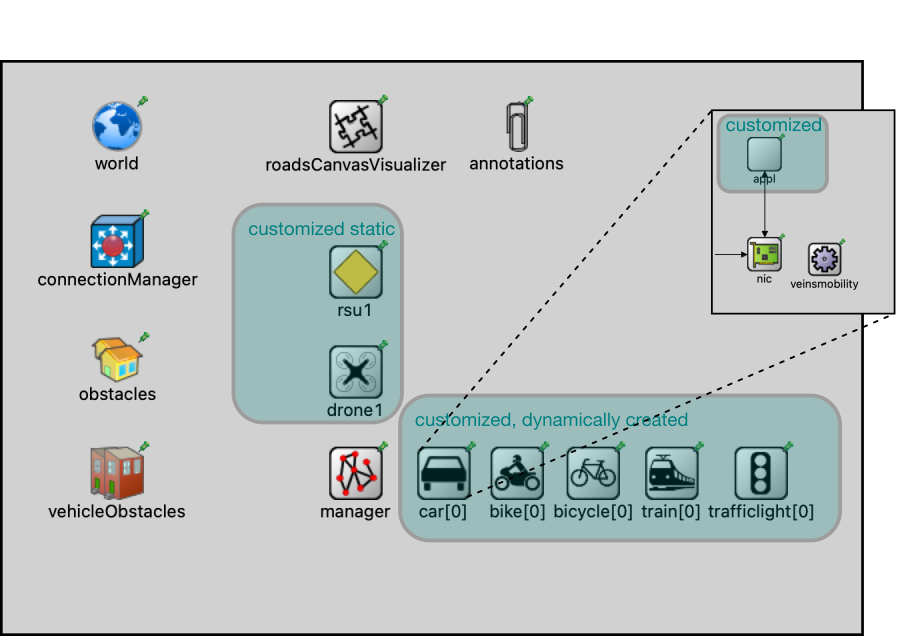
Modules of a typical Veins simulation
…a Veins_INET simulation can mix both module libraries: It can use Veins_INET modules (which are based on Veins modules) for creating/moving/destroying OMNeT++ modules (according to cars/bikes/bicycles/trains/etc in a road traffic simulation executing in SUMO). These OMNeT++ modules, in turn, can then use modules from the INET Framework (as well as any module libraries based on the INET Framework like SimuLTE and Simu5G) for simulating radio communication (shown in green in the figure below).
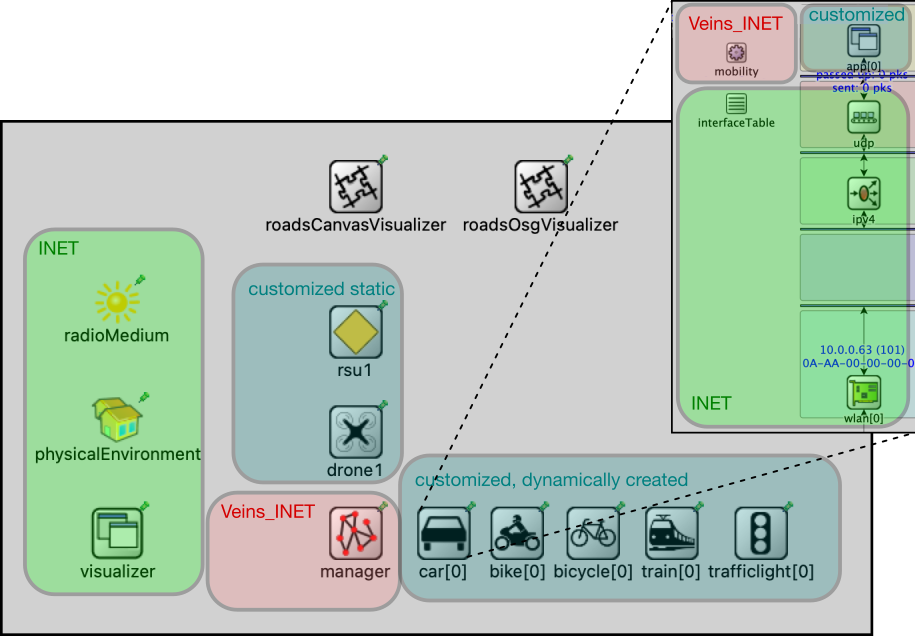
Modules of a typical Veins_INET simulation
This makes it possible to combine the best of both worlds for many simulation tasks: using Veins as a solid basis for bidirectionally coupling a network and a road traffic simulation as well as setting up, running, evaluating, and managing these simulations – as well as relying on the rich feature set outside of purely WLAN based V2X communication offered by the INET Framework and related module libraries.
It is, of course, possible to use both radio communication stacks in parallel; that is, after instantiating all corresponding support modules (mobility, radio medium, obstacles, etc) of both Veins and the INET Framework, a compound module may use both modules of the Veins radio stack and modules of the INET Framework radio stack (e.g., to mix communication technologies), though such simulations are typically better served using only modules of the INET Framework.
The INET Framework and model libraries based on it are available as a separate download from the following websites.
INET Framework Website SimuLTE Website Open C-V2X Website Simu5G Website
The subproject can be imported into the OMNeT++ IDE by importing the subprojects/veins_inet folder (or the subprojects/veins_inet3 folder, for INET 3) into the workspace (or by selecting the Search for nested projects when importing Veins).
An example simulation in the examples/veins_inet subdirectory of the project illustrates how Veins_INET is used:
Wireless nodes representing cars can inherit from the standard INET WirelessHost, using a regular INET network card, e.g., of type Ieee80211MgmtAdhoc along with a full TCP/IP stack.
Each car uses a mobility module of type VeinsInetMobility to track its position.
To configure the network stack of cars entering a simulation, an additional HostAutoConfigurator module needs to be included with each car.
A global module, VeinsInetManager, creates and manages cars in the simulation.
This subproject is included since Veins 4.5.
Veins_MATLAB Project
Veins_MATLAB is an externally-hosted project that serves as an example of how to use MATLAB or Simulink models from a Veins simulation.
An example simulation in the examples/veins_matlab subdirectory of the project illustrates how Veins_MATLAB is used: an OMNeT++ simple module HelloMatlab.ned calls a function defined in testFunction.m.
MATLAB and Veins_MATLAB are available as separate downloads from the following websites.
Veins_MATLAB Website MATLAB Website Simulink Website
Veins_Python Project
Veins_Python is an externally-hosted project that serves as an example of how to use Python from a Veins simulation.
An example simulation in the examples/veins_python subdirectory of the project illustrates how Veins_Python is used: an OMNeT++ simple module ApplicationLayerTest.cc calls a function funtest(a, b) defined in a sample python module py2veins.
This python function, in turn calls a function testfun() defined in the sample OMNeT++ module ApplicationLayerTest.cc
Veins_Python is available as separate download from the following websites.
Veins_Python WebsiteReinforcement Learning (Veins-Gym)
Machine Learning is becoming ever more popular in many application domains, including vehicular networking. It has been shown already that Intelligent Transportation Systems can greatly benefit from this approach, particularly from Reinforcement Learning (RL). To implement Vehicular Ad-hoc Network environments for RL training, researchers often start from scratch, because up until now, there is neither an established interface to ML toolkits nor a common scenario for VANET applications. Veins-Gym was developed to provide this tooling.
Veins-Gym exports Veins simulations as Open AI Gyms. This enables the application of Reinforcement Learning algorithms to solve problems in the VANET domain, in particular popular frameworks such as Tensorflow or PyTorch.
Please refer to the following publication for a detailed description of Veins-Gym:
-
 Max Schettler, Dominik S Buse, Anatolij Zubow and Falko Dressler, "How to Train Your ITS? Integrating Machine Learning with Vehicular Network Simulation," Proceedings of IEEE Vehicular Networking Conference, 2020, pp. 4.
[DOI]
Max Schettler, Dominik S Buse, Anatolij Zubow and Falko Dressler, "How to Train Your ITS? Integrating Machine Learning with Vehicular Network Simulation," Proceedings of IEEE Vehicular Networking Conference, 2020, pp. 4.
[DOI]
Veins-Gym is available as separate download from the following website.
Veins-Gym WebsiteFederated Learning (Flexe)
Flexe is a new framework for simulation of Federated Learning in Connected and Autonomous Vehicle (CAVs). Its adaptable design allows for the implementation of a variety of Federated Learning schemes, including horizontal, vertical, and Federated Transfer Learning.
The project consists of two software packages: one for vehicle-to-vehicle communication (Flexe) and one for the construction and training of models (PyFlexe).
Please refer to the following publication for a detailed description of Flexe:
-
Wellington Viana Lobato Junior, Joahannes B. D. da Costa, Allan Mariano de Souza, Denis Rosário, Christoph Sommer and Leandro Aparecido Villas, "FLEXE: Investigating Federated Learning in Connected Autonomous Vehicle Simulations," Proceedings of 96th IEEE Vehicular Technology Conference (VTC 2022-Fall), London, United Kingdom, September 2022. [DOI]
Flexe is available as separate download from the following website.
Flexe Website5G
See Veins_INET.
Scroll to Veins_INETFurther Modules
A complete list of all available modules as well as full API documentation is available from the downloaded Veins source bundle as documented above.